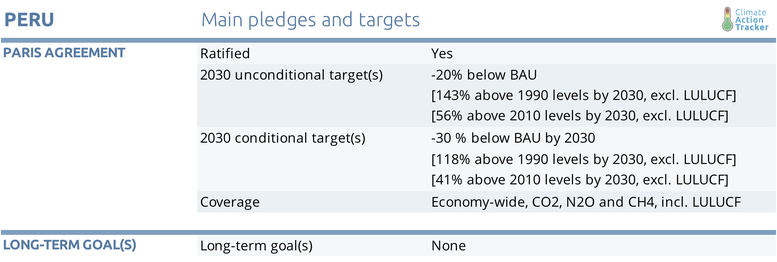Country summary
Overview
According to our new assessment, Peru’s current policies would lead to it overachieving its Paris Agreement unconditional Nationally Determined Contribution (NDC) target. The government will need to put additional measures in place to comply with its 30% reduction conditional target.
During 2019, the government efforts have mainly focused on two objectives: developing and approving the “Road Map for NDC implementation” including 153 actions, 62 on mitigation and 91 for adaptation; and holding a participatory consultation process on the regulation of the framework law on climate change.
In 2017, the government established a multi-sectoral working group to prepare a “Road Map for the implementation of the NDC”. During 2019, this working group reviewed the 76 mitigation options identified in the 2015 iNDC and came up with a revised version including 62 mitigation options in seven sectors. It is expected that the implementation of these 62 measures will reduce close to about 23% of the 2030 GHG emissions, leaving a 6.7% gap needed to achieve the 30% conditional NDC target.
The working group has further identified additional measures to be considered in the energy and LULUCF sectors, which would lead to a 31.7% reduction below BAU in 2030, slightly overachieving their conditional target. These last set of measures are yet to be approved and adopted by the multi-sectoral NDC Commission.
In 2018, the Peruvian Government published its first framework law on climate change. During most of 2019, the government held a participatory consultation process on the regulation of the framework. The regulation of the framework law is expected to be approved at the end of this year, which would make the Climate Change law operational as of 2020 and Peru’s Paris Agreement pledge legally binding.

We rate Peru’s NDC targets “Insufficient.” The “Insufficient” rating means that Peru’s climate commitment is at the least stringent end of what would be a fair share of global effort and is not consistent with the Paris Agreement’s 1.5°C limit, unless other countries make much deeper reductions and comparably greater effort.

Under current policies, Peru’s is expected to overachieve the country’s unconditional NDC target (excluding LULUCF). However, the government will still need to put additional measures in place to comply with their conditional target. Given that Peru is already moving towards the achievement of its NDC targets, it is also a good time to start discussing options to raise ambition of their mitigation goals, in light of the next NDC submission round, expected by 2020.
In the energy sector, Peru is lagging behind in its efforts to increase the share of renewables, currently at 21%, compared with its Copenhagen pledge of 40% renewable energy by 2021.
Deforestation remains a critical problem in Peru due to expansion of palm oil, agriculture, illegal logging and informal mining. Under current policies projections for the LULUCF sector, emissions from Peruvian deforestation are projected to increase by 82–84% between 2012 and 2030, a growth rate not seen before in Peru’s history. This appears to be at odds with Peru’s refined Copenhagen pledge of reducing LULUCF emissions to zero by 2021. As world LULUCF emissions would need to decrease towards 2030 to fall in the Paris Agreement emissions pathway, Peru needs to address—and prevent—this significant projected increase.
Further analysis
Latest publications
Stay informed
Subscribe to our newsletter




